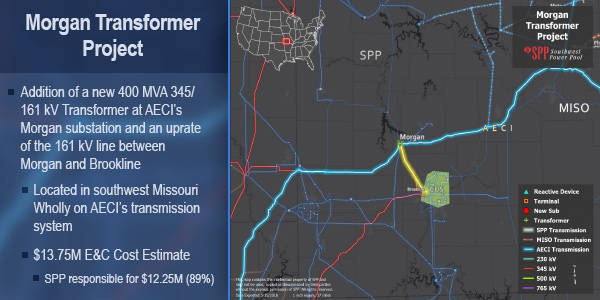FERC last week approved SPP’s first seams project with a neighboring utility when it accepted Tariff revisions incorporating a cost-sharing and usage agreement with Associated Electric Cooperative Inc. (AECI).
The Oct. 10 letter order allows SPP and AECI, a Missouri-based collection of six generation and transmission cooperatives, to proceed with the Morgan transformer project. It was the entities’ second attempt to gain FERC approval (ER18-2243, ER18-2245).
SPP says the project is the most efficient, cost-effective solution to economic and reliability issues identified in two separate studies. It also said the project will reduce day-ahead market uplift costs and avoid the cost of a more expensive regional solution, resulting in a regionwide load-ratio-share benefit of more than $17 million.
The RTO included both arguments in its revised filing, after its first attempt failed in 2017. (See FERC Rejects Cost Allocation for SPP-AECI Seams Project.)
SPP has proposed to regionally fund the project, as it will solve congestion issues on its side of the seam. The RTO will cover 82.91% of the $13.75 million engineering and construction cost, while AECI will cover the remainder and is responsible for the project’s construction, operations and maintenance.
David Kelley, the RTO’s director of seams and market design, told RTO Insider that FERC’s approval “is evidence it’s possible to share both costs and benefits of new transmission projects across regions.”
“We continue to work with all of our seams partners to enhance our processes to identify and approve mutually beneficial transmission projects,” Kelley said.
The Morgan project comprises a new 345/161-kV transformer at AECI’s Morgan substation and an uprated 161-kV line, both near Springfield, Mo. It was identified during an SPP-AECI 2016 study as outlined by the entities’ joint operating agreement and by the RTO’s 2017 10-year assessment.
“It’s important to SPP and our industry to continue to provide affordable and reliable electricity to our customers, and our success in doing so will depend more and more on our ability to work across regional boundaries to create win-win scenarios,” Kelley said.
SPP said stakeholders, its Board of Directors and state regulators have consistently recommended regionwide cost allocation for the Morgan project.
FERC last year rejected SPP’s first attempt to allocate the project’s costs, ruling it had not shown that the proposed allocation on a regionwide, load-ratio-share basis was “roughly commensurate” with the project’s benefits.
The commission in 2015 also rejected SPP efforts to create a new class of seams transmission projects, saying its plan to identify projects outside the Order 1000 interregional planning process was “too broadly drawn” (ER15-2705). FERC did allow SPP to make filings on a project-by-project basis for non-Order 1000 facilities. (See FERC Rejects SPP Proposal for Seams Transmission Projects.)
FERC does not comment beyond an order’s language. A spokesperson would not confirm whether this was the first interregional project the commission has approved on a case-by-case basis.
August M2M Payments Again in MISO’s Favor
Replicating an outcome last seen two years ago, the market-to-market (M2M) process between SPP and MISO resulted in the latter receiving more than $531,000 in payments for August.
MISO last received back-to-back payments in July and August 2016, the beginning of the only three straight months the RTO has seen M2M payments in its favor. SPP has been on the right side of the ledger 19 of the 21 ensuing months.
Temporary flowgates were binding for 327 hours in August, resulting in $788,835.60 in M2M payments to MISO. That was reduced by $257,098.85 for permanent flowgates binding for 127 hours in SPP’s favor.
SPP still has as healthy balance of almost $51.4 million in M2M payments since the process began in March 2015.
— Tom Kleckner







